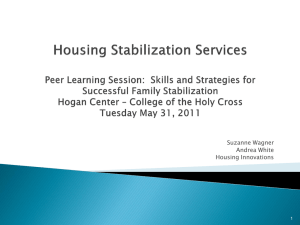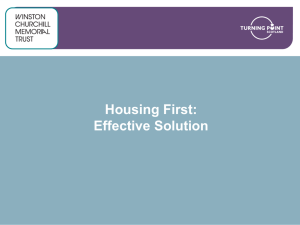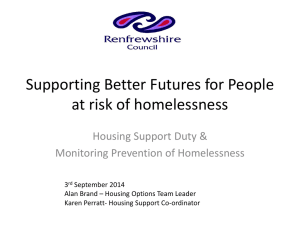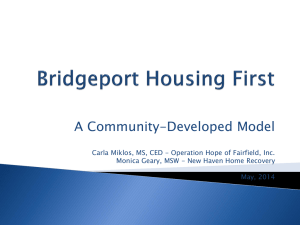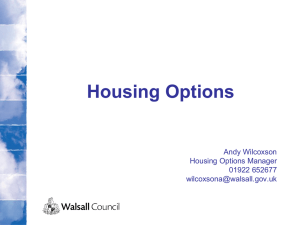February 2015 Rapid Re-Housing Training
advertisement
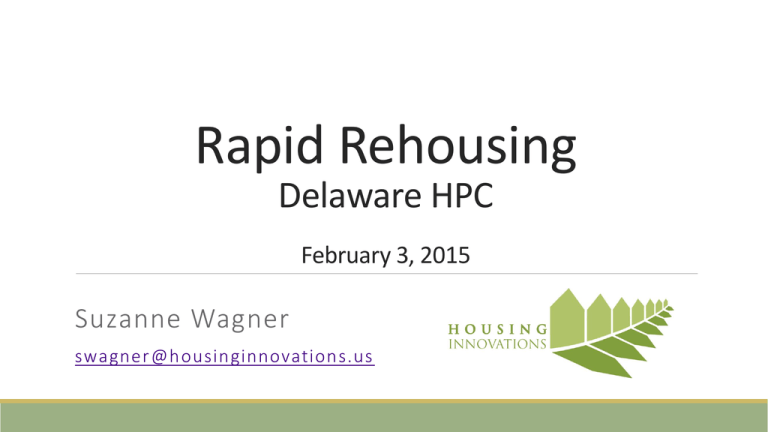
Rapid Rehousing Delaware HPC February 3, 2015 Suzanne Wagner swagner@housinginnovations.us Agenda • • • • • • • • • Introductions Policy Context RR Definitions and Benefits Progressive Engagement Housing Planning Housing Location Housing Stabiliyu Case Management Support Community Connections and Supports Wrap-up and Discussion 2 Housing Innovations • Began in 2009 • Principals: Suzanne Wagner, Andrea White, Howard Burchman • Senior Associate: Lauren Pareti • Experience: Columbia University Community Services/CUCS & Burchman Terrio • Extensive experience in: • • • • • • Developing, Operating and Evaluating Housing and Service Programs Implementing Evidence Based Practices (EBP’s) CoC Support and System Transformation Homeless Planning and Community Needs Assessments Operating Coordinated Access and Assessment Systems Staff Training 3 National Trends and Best Practices HEARTH – Homeless Emergency Assistance and Rapid Transition to Housing Federal Strategic Plan (FSP), Opening Doors 4 National Trends ◦ End homelessness as quickly as possible and get people to permanent housing solutions through outcome driven approach ◦ Use Evidence-Based Practices (EBP’s) ◦ Expand Rapid Re-housing ◦ Target Permanent Supportive Housing for the most disabled people who have been homeless the longest ◦ Housing First as both a system and program strategy Lack of evidence that housing readiness increases chance of housing stability 5 National Trends - 2 ◦ Preserve intensive interventions for people with highest need ◦ Connect people to work, benefits and mainstream and community-based services and supports ◦ Transform systems and programs that are not effective and/or efficient 6 “to establish a Federal goal of ensuring that individuals and families who become homeless return to permanent housing within 30 days” HEARTH Act Purposes – Sec. 1002(b) Federal Strategic Plan (FSP) Goal Transform homeless services to crisis response systems that prevent homelessness and rapidly return people who experience homelessness to stable housing. 8 HEARTH Performance Measures Reduce Overall Homelessness Reduce the number of people who become homeless Prevention/ Diversion Reduce length of homelessness Rapid Re-Housing / Housing First Reduce returns to homelessness Housing Stabilization Support Increase employment and other income Housing Stabilization Other accomplishments related to reducing homelessness Example: Doubled up Thoroughness in reaching homeless population Count well Ensure all pops served Rapid Exit and Rehousing Main Goal – Rapid Access to Housing Focus on Relocation and Stabilization CoC funds can be reallocated to RR for Families Housing Shelter Source: NAEH Center for Capacity Building 10 Housing First Programmatic and systems approach that provides people with housing quickly and then providing services as needed Low barrier entry requirements and service rich environment Participant have choices about housing and services Housing is not contingent on compliance with services – Participants expected to comply with a standard lease agreement Provided with services and supports to help maintain housing Services and connections to resources provided post-housing to promote housing stability, stable tenancy and well-being 11 Prevailing Model Emerging Model Employment Assistance Employment Assistance Day Care Day Care Shelter Housing Stabilization Shelter Housing Placement MH/SA Services Family Supt Services MH/SA Services Family Supt Services Turning the Continuum of Care Inside – Out? Source: Culhane, Homeless Assistance: A Paradigm Shift? 12 Rapid Rehousing Defined Goal: Rapidly exit homeless individuals and families into permanent housing from the homeless system ◦ One-time/time-limited financial help with debts, security costs, rent and other housing costs ◦ Short term rental assistance up to 24 months – preferably in 3 month increments ◦ Housing location services ◦ Case management focused on increasing income, housing stabilization, connections to services and supports 13 Principles of Rapid Rehousing Move from homelessness directly to housing Targeting “Just enough” Assistance Landlords are valuable resources Use case management and mainstream resources to keep tenants stable ◦ Source: HPRP Promising Practices in Rapid Rehousing – HUD OneCPD 14 Benefits of Rapid Rehousing Cost-effective and proven strategy Keeps expensive PSH units for the most vulnerable Reduces the amount of time families remain in crisis of homelessness (it is trauma-informed) Helps communities leverage new partners and resources 60-75% of families enter from friends and family; About 50% return to same place they were before shelter 15 RR Benefits - 2 Addresses barriers homeless people face: ◦ The cost of obtaining new rental housing ◦ Landlord discrimination Obtain permanent housing and stabilize quickly Change the focus of the emergency system from emergency placement to rehousing Open the back door – free up emergency shelter space 16 Rapid Rehousing Outcomes Effective for large percentage of families ◦Low cost per outcome ◦High rates of exits to permanent housing ◦Low rates of returns to homelessness 17 Exits to Permanent Housing for Households with Children Source: Data from 14 Continuums in seven states that prepared Evaluators for NAEH Performance Improvement Clinics in 2011-2012 Shelter Transitional Housing Rapid Re-Housing Rate of Return to Homelessness w/in 12 Mos of Exit Source: Data from 7 CoCs in 4 states that prepared Evaluators for NAEH in 2012 Singles People in Families with Children Average Cost Per Exit for Families with Children Source: Data from 14 CoCs from NAEH Performance Improvement Clinics in 2011-2012 All Exits Permanent Housing Exits Lessons from VA Rapid Rehousing (SSVF) Small amounts of assistance can be effective: • Avg cost/household served: $2,410 • Median length of assistance: 90 days • • • Only 13% of RRH participants received assistance for >180 days 79% of participants exited to permanent housing 93% of families did not return to VA homeless programs (after one year) RRH can work for people with barriers to housing stability • 76% of households had income of less than 30% of AMI • 55% of Veterans served had a disabling condition Source: Impact and Performance of the Supportive Services for Veteran Families (SSVF) Program: Results from the FY 2013 Program Yr What about TH? HUD :“Life After Transitional Housing”, Urban Institute, March 2010 http://huduser.org/portal/publications/LifeAfterTransition.pdf Findings high and low barrier families did equally well for the most part More or less rules did not make a difference in outcomes What DID make a difference was time spent homeless… Longer time homeless, less likely to have own housing at exit HH w/more homeless episodes, odds of not working and lower wages Bottom line – end people’s homelessness rapidly 22 Implementing RR using Progressive Engagement Progressive engagement: • Start with a small amount of assistance for a lot of people • Add more as needed • Rental assistance in 3 month increments • Re-assess to determine continued need 23 What does Progressive Engagement look like? Provide a minimal amount of assistance to all people ◦ Lists of vacancies, help funding a place to live, small amount of financial assistance Provide additional assistance as needed by the household ◦ Short term rental assistance, case management If at risk of losing housing ◦ More rental assistance and/or more CM If still at risk ◦ Longer tem RA and/or more CM If still at risk – maybe voucher or PSH 24 Example of Progressive Engagement Housed Point of Entry RRH 1 $ RRH 2 $$ RRH 3 $$$ Source: NAEH Center for Capacity Building Subsidy/ PSH $$$$ 25 Rationale for PE Nationally recognized practice in addressing homelessness Provides customized levels of assistance Preserves the most expensive interventions for households with demonstrated barriers to housing success Enables service delivery systems to effectively target resources 26 Rationale - 2 Based on research (or lack thereof) that we cannot predict who will need what type of intervention ◦ No validated predictive assessment instruments except for diversion ◦ Alameda County – similar outcomes for high and low barrier households ◦ People are resilient Resources are limited More information about barriers to housing stability when we see people in “real” housing 27 A word about Transitions…… New start Involve both loss and gain Stressful Can increase depression/substance use Unknown/uncertainty leads to fear Require re-alignment of daily schedule Trigger fears of failure Require support 28 Rapid Rehousing Activities and Services Housing Planning Housing Location Case Management and Housing/Tenancy Support Community Connections and Supports Layers other Evidence-Based and Promising Practices: Critical Time Intervention, Housing First, Person Centered Planning, Trauma-Informed Care 29 Housing Planning 30 Housing Planning • Assessment of Housing and Homeless History • Assessment of Strengths and Barriers to Housing Stability • Education on Tenancy Role and Housing Options • Connection to Resources • Core Concepts in Housing Planning • Using Shared Decision Making Model • Components of a Housing Plan 31 Assess Housing and Homeless History Past housing experiences Current housing goals Experience as a leaseholder What they liked/didn’t like about previous housing How person/family became homeless Barriers to access and sustainability Ability to complete paperwork, view apartments, handle interviews 32 Assessment Domains •Demographic Information •Education History •Housing and Homelessness •Family, Friends and Supports •Employment History •Physical and Behavioral Health •Income, Benefits, Debts •Life Skills •Legal • Summary: Barriers & Strengths 33 Education on Tenancy Rights AND Responsibilities The lease lays out the structure to maintain tenancy In order to follow commitments people have to understand them Knowing what is expected allows people to plan The lease should be reviewed early and often Catching lease violations early will avoid a crisis 34 Expectations of Tenancy Paying Rent • Income, Financial Management, Subsidy Administration • Logistics: check or money order, timeliness Maintaining Apartment • Understanding and Meeting Cleanliness Standard, Managing Repairs • Inspections Allowing Others the Peaceful Enjoyment of Their Homes • Getting along with neighbors, Visitors • Following rules re noise etc. Occupancy • Only people on the lease live there Connection to Resources • Connect with Resources needed to maintain housing • Financial resources and plan to meet needs • Services including children’s • Supports both existing and new and plan to maintain housing and use of time • Role of case management • Accompany to resources including housing 36 Focused Service Planning Limit the areas of intervention Focus on the most pressing needs that impact community stability Usually not be a linear process Relate all interventions to long term goals Help people move-away from crisis-driven lives 37 Practice of Shared Decision Making Recognize a decision needs to be made Identify the participants as equals View options without judgment Explore understanding and expectations Identify preferences Negotiate Share the decision Evaluate outcomes 38 Case management role in SDM Structure regular care planning meetings Support/assist individuals to negotiate their needs Fully embrace strengths-based approach Assist person to identify his/her personal medicine Participate in evaluation of the outcomes 39 Components of the Plan - Goals • • • • • Goals set as a team of family and worker Focus on the issues that affect stability in the community – base on the current crisis and previous episodes of community instability Immediate and longer term goals clear • Use the plan for the intervention Steps to reach goal clearly defined and measurable Longer term needs require connections to other resources. 40 Components of the Housing Plan Participant/Tenant and Worker Role • Designs plans for at least monthly in housing access phase and every month for the first months in housing • Reflects areas of the assessment • Prioritizes areas for work • Sets time frames for work to be accomplished 41 Components of the Housing Plan Resource Identification • Clearly defines resources needed to access and/or maintain housing including: • Income, credit repair, legal services, employment assistance/support, financial planning and management, medical services, child care, educational support, access to community based services such mental health, substance abuse, recreation/socialization etc. 42 Evaluating the Plan Measure Success • Uses documented steps to reach goal and benchmarks set • Uses phases to gauge expectations and progress • Identifies need to renegotiate goals and resources •Reframe setbacks as learning opportunities 43 Housing Location 44 Housing Location • Assessment of Needs and Preferences • Barriers to Housing Access • Connections to Landlords • Negotiating Barriers and Preferences • Financial Requirements 45 Housing Needs and Preferences Location Access to Transportation Proximity to Significant Others Proximity to Services and Community Resources Unit Size and Housing Density Amenities Special accommodations Pets Ideal v. acceptable, negotiable/non-negotiable 46 Financial Needs/Requirements UP FRONT NEEDS ONGOING NEEDS Security Deposit First months Rent Utility Moving costs Furniture 47 Barriers to Securing Housing Person’s ability to negotiate and complete process Locating acceptable housing Transportation Background checks conducted by landlords • Credit • Criminal background 48 Negotiating Preferences And Background Issues Preferences ◦ Identify what is negotiable and what is not ◦ Let people dream a bit – what is their ideal, what do they have now, what would they accept ◦ See option available as step towards goal Background Problems ◦ Identify what is different now from when issue occurred ◦ Plan for not happening again ◦ Line up supports ◦ Practice discussing with potential landlords 49 Engaging Landlords Landlord Goals Regular rent payment No problems Low turnover Explain support that case manager can provide Ask landlords for other landlords they know Be responsive 50 Housing and Tenancy Support 51 Housing Retention • Re-Assessment • Identifying Preferences: what is working, what is not? • Any new needs and/or goals? • Re-Education • Assertive Outreach and Engagement by Worker • Work with Landlords and Resources to Address Barriers to Housing Retention • Case Study: Develop a plan 52 Re Assessment and Education Re-assessment: needs, preferences and goals change once in housing ◦ Assessments evolve over time ◦ Home visits will provide additional information Link assessment to the lease and goal of housing retention Verify the information: check in with landlords on lease complaisance Review Obligations of Tenancy 53 Base for Communication A thorough housing and homeless history A plan as to how each tenant will meet tenancy obligations Knowledge of tenants rights and responsibilities Resources to help address tenancy barriers 54 Working with Landlords • Landlords and property managers establish tenancy obligations and enforce them. • Set up communication structure and arrange for early warnings of any issues – reach out monthly • Focus on eviction prevention and use the structure of the lease to guide your interventions • Negotiate a head of time a clear understanding of landlord process • Visit the home often • Probe for any threats to tenancy to prevent eviction 55 Tenants Rights and Responsibilities Know tenant’s and landlord rights and responsibilities State of Delaware Landlord Tenant Code: http://legis.delaware.gov/Legislature.nsf/1688f230b96d580f85256ae2 0071717e/1f058f9cecf0e1bd85256f7000607756/$FILE/lanten.pdf Brochure – Delaware Landlord Tenant Code, Delaware Attorney General Landlord Tenant Code brochure.pdf http://attorneygeneral.delaware.gov/documents/brochures/2013/La ndlord%20Tenant%20Code.pdf 56 Connect to Resources Based on the assessment, identify new resources needed Engage tenants in a discussion as to whether current resources are working/not working Be in regular contact with resources to assess progress Identify new resources needed based on revised or new goals or barriers to retention 57 Example: Retention Plan Mary and her children have been in housing for a month. On a home visit you notice that the other tenants are giving Mary the stink-eye. Mary has done well in housing and has been paying the rent. She struggles some with money but has been able to get resources to help. You worry about this new development. Mary explains sometimes she lets the children play in the hallway. They are noisy and too cooped up in the apartment. She knows it bothers some of the cranky neighbors but the landlord has not complained. What else is she supposed to do? 58 Worker Role Providing assistance to help participants develop structure and purpose in their lives. • Something to do during the day provides a framework and creates expectations • Behaviors that interfere with housing decrease • This gives another early warning system to prevent crisis Coordinate closely with resources • Checking in with landlord, and all services and supports to ensure it is working and identifying glitches 59 Worker Role Eviction Prevention The eviction process can be a process to preserve tenancy Negotiate with landlords before the eviction notice • Landlords do not want to evict it is expensive • See if they will accept payment plans • If they will let you know about lease violations • How much time will they give the tenant to correct 60 Harm Reduction Plan: Risk Options Factors in favor Harm Reduction Plan Eviction: tenant • Go to friends • Solve landlord has ‘guests’ in apartment, disturbing other tenants house issue • Meet goal to see friends Non-negotiable Factors against factors • Transportation • Disruption issues must stop • Find another location to socialize • Would reduce impact on neighbors • Would cost • Drinking, something Not smoking may welcomed not be permitted • Find a time to socialize that is less disruptive to neighbors • Could have • ‘Friends’ aren’t • Must always reduced impact up and don’t allow on neighbors want to neighbors socialize ‘peaceful earlier enjoyment’ 61 Community Resources 62 Involving Community Agencies You need all resources available to support tenancy • Tenant Lawyers: • Train tenants and staff on tenants rights. • Will provide support to tenants in the eviction process • May assist to address debts interfering with housing • Landlords: • Assertive property management making the lease and enforcement clear • Sending notices early and connecting with services 63 Involving Community Agencies Treatment Resources: • Having emergency treatment available in a timely manner • Easy access to treatment on demand • High quality, sustainable and flexible • Provides consultation to staff on planning Family and Friends • Often provides motivation for keeping the apartment • May provide support to person addressing issue and barriers • Provides a role for person in the community 64 Involving Community Agencies Benefits providers: • Increasing income • May provide some emergency resources for rent arrears or utilities, damages Employment: • May provide motivation to address barriers to tenancy • Gives structure and purpose, role • Provides income 65 Building Skills • • • • • • • • • Educating on rights and responsibilities Focusing on skills for adulthood for Children Modeling for each person/family to negotiate for services Trying it out and debrief Establishing regular check-ins to see if it is working Review cost and benefits – critical thinking Recognizing strong partners and good skills Renegotiate the relationship as necessary Reach for feedback on the RRH orker - opportunity to practice Changing Expectations Moving from crisis to planning • May be from immediate to 15 minutes from now Critical thinking • Using strategies and resources that work best for each person Structure and purpose • Developing a structure and purpose to days outside the hospital Developing new or changed life roles • From patient to tenant, family member, student, worker, advocate, artist Crisis Planning At a moment of calm it is often helpful to develop a crisis plan with individuals: • Standard Crisis: Fire, Evacuation, Injury or Medical Emergency. • Individual based on patterns: • Psychiatric, Medical, Substance, Money, Conflict, Threat to tenancy What is the structure? What would work best in this situation? Who should be involved? Supervisory Support Communication with Supervisors • Regularly scheduled meeting (preferably weekly) • Review all people on caseload at least monthly • Discuss participants that are at risk • Lease violations or barriers to accessing housing • People who have difficulty engaging • Behaviors that interfere with housing and goals – brewing • Identify behaviors that are not clear: • Seems engaged but disappears, landlord complaining but do not see the behavior 69 Supervisory Support Identify things that have gone well • Participant who negotiated a payment plan • Someone who responded to landlord notice and accepted help in cleaning apartment • Get support with landlords • Landlord does not enforce the lease • Landlord is overinvolved • Get support with resources • What is working and not working •Seek out support in addition to meetings if needed • 70 Connection to CTI Needs Assessment and Re-Assessment Focused Housing Planning Intensive in the First 3 months (BCTI) Connection to Resources Connection with Landlords Skill development Structure and Purpose Moving from Crisis 71 Measures of Success • Maintaining housing and not returning to homelessness • Increase income • Network of supports • Less emergency interventions: ER visits, hospitalization, incarceration, removal of children, school truancy • Structure, role and purpose in each person’s life 72 Closing ◦ Connect housing stability to person’s aspirations and goals ◦ Assist with transition to new role ◦ Build skills and knowledge in meeting lease obligations ◦ Help people move away from crisis - Crisis Prevention orientation ◦ Regularly probe for threats to housing and intervene early ◦ Maintain contacts with resources ◦ Build competence and confidence 73 Closing and Discussion 74
